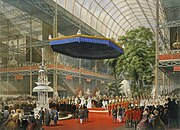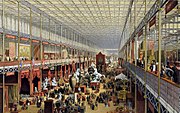| Stéphane Mallarmé | |
|---|---|
 | |
| Born | March 18, 1842 Paris, France |
| Died | September 9, 1898 Paris, France |
| Occupation | poet |
| Nationality | French |
| Literary movement | Parnassian poets,Symbolist poets |
Influences | |
Influenced | |
Stéphane Mallarmé (French pronunciation: [malaʁˈme]) (March 18, 1842 – September 9, 1898), whose real name was Étienne Mallarmé, was a French poet and critic.
Biography
Mallarmé was born in Paris. He worked as an English teacher, and spent much of his life in relative poverty; but he was a major French symbolist poet and rightly famed for his salons, occasional gatherings of intellectuals at his house for discussions of poetry, art, philosophy. The group became known as les Mardistes, because they met on Tuesdays (in French, mardi), and through it Mallarmé exerted considerable influence on the work of a generation of writers (see below).
His earlier work owes a great deal to the style established by Charles Baudelaire. His fin de siècle style, on the other hand, anticipates many of the fusions between poetry and the other arts that were to blossom in the Dadaist, Surrealist, and
Some consider Mallarmé one of the French poets most difficult to translate into English. This is often said to be due to the inherently vague nature of much of his work, but this explanation is really a simplification. On a closer reading of his work in the original French, it is clear that the importance of sound relationships between the words in the poetry equals, or even surpasses, the importance of the standard meanings of the words themselves. This generates new meanings in the spoken text which are not evident on reading the work on the page. It is this aspect of the work that is impossible to render in translation (especially when attempting a more literal fidelity to the words as well), since it arises from ambiguities inextricably bound in the phonology of the spoken French language. It can also be suggested that it is this 'pure sound' aspect of his poetry that has led to its inspiring musical compositions (see below), and to its direct comparison with music.
A good example of this play of sound appears in Mallarmé'sSonnet en '-yx'. The poem opens with the phrase ses purs ongles ('her pure nails'), whose first syllables when spoken aloud sound very similar to the words c'est pur son ('it's pure sound'). This use of homophony, along with the relationships and layers of meanings it results in, is simply impossible to capture accurately through translation.[1]
For many years, the Tuesday night sessions in his apartment on the rue de Rome were considered the heart of Paris intellectual life, with W.B. Yeats, Rainer Maria Rilke, Paul Valéry,Stefan George, Paul Verlaine, and many more in attendance, as Mallarmé held court as judge, jester, and king.
He died in Valvins in 1898.
Influence
Mallarmé's poetry has been the inspiration for several musical pieces, notably Claude Debussy'sPrélude à l'après-midi d'un faune (1894), a free interpretation of Mallarmé's poem L'après-midi d'un faune (1876), which creates powerful impressions by the use of striking but isolated phrases.Maurice Ravel set Mallarmé's poetry to music in Trois poèmes de Stéphane Mallarmé (1913). Other composers to use his poetry in song include Darius Milhaud (Chansons bas de Stéphane Mallarmé, 1917) and Pierre Boulez (Pli selon pli, 1957-62).
The poet and visual artist Marcel Broodthaers was strongly influenced by Mallarmé, as evidenced by his Un coup de Dés, based on the typographical layout of Mallarmé's, but with the words blacked over by bars.
The Dadaist artist Man Ray's last film, entitled
It has been suggested by some that much of Mallarmé's work influenced the conception of hypertext, with his emphasis on the importance of space and placement on the page. This becomes very apparent in his work "Un coup de dés jamais n'abolira le hasard" ('A roll of the dice will never abolish chance'). The placement of the words, the relationship between form and content, and all the different ways, combinations and permutations that one can read the poem are truly groundbreaking.
Prior to 2004, "Un Coup de Dés" was never published in the typography and format conceived by Mallarmé. In 2004, 90 copies on vellum of a new edition were published by Michel Pierson et Ptyx. This edition is a restitution of the typography originally designed by Mallarmé for the projected Vollard edition in 1897 and which was abandoned after the sudden death of the author in 1898. This restitution has been made from the proofs which are kept in the Bibliothèque Nationale of France, taking into account the written corrections and wishes of Mallarmé and correcting certain errors on the part of the printers Firmin-Didot.
For the first time, all the pages are printed in the format(38cm by 28cm) and in the typography chosen by the author and it is now at last possible, more than 100 years after its conception,to see and read the "Coup de Dés" as Mallarmé" wanted it to be "in its exact spiritual setting," without dissociating content and form or the spirit of the lettering.
A copy of this new edition can be consulted in the Bibliothèque François-Mitterand. Copies have been acquired by the Bibliothèque littéraire Jacques-Doucet and Irvine University, California, as well as by private collectors. A copy has been placed in the Museum Stéphane Mallarmé at Vulaines-sur-Seine, Valvins, where Mallarmé lived and died and where, according to Paul Valéry, he made his final corrections on the proofs prior to the projected printing of the poem.
Refs: On the publishing of "Un Coup de Dés" and its mishaps after the death of Mallarmé, consult the notes and commentary of Bertrand Marchal for his edition of the complete works of Mallarmé, Volume 1, Bibliothèque de la Pléiade, Gallimard 1998. To delve more deeply, "Igitur, Divigations, Un Coup de Dés," edited by Bertrand Marchal with a preface by Yves Bonnefoy, nfr Poésie/Gallimard
Mallarmé is referred to extensively in the latter section of Joris-Karl Huysmans' À rebours, where Des Esseintes describes his fervour-infused enthusiasm for the poet: "These were Mallarmé's masterpieces and also ranked among the masterpieces of prose poetry, for they combined a style so magnificently than in itself it was as soothing as a melancholy incantation, an intoxicating melody, with irresistibly suggestive thoughts, the soul-throbs of a sensitive artist whose quivering nerves vibrate with an intensity that fills you with a painful ecstasy." [p.198, Robert Baldick translation]
Works
- In 1875, he translated Edgar Allan Poe's The Raven into French, while Impressionist painterEdouard Manet illustrated it.
- L'après-midi d'un faune, 1876
- Les Mots anglais, 1878
- Les Dieux antiques, 1879
- Divagations, 1897
- Un coup de dés jamais n'abolira le hasard, 1897
- Poésies, 1899 (posthumous)
- Mallarmé: The Poems (trans. Keith Bosley, 1977)
References
- ^ Roger Pearson, Unfolding Mallarme. The development of a poetic art. Oxford: Clarendon Press, 1996. ISBN 019815917X
External links
- Mallarme.net contains texts of most of the poems and commentary. (French)
- Works by Stéphane Mallarmé at Project Gutenberg
- Artist & composer Daniel Dutton's illustrated version of "The Faun"
This entry is from Wikipedia, the leading user-contributed encyclopedia. It may not have been reviewed by professional editors (see full disclaimer)













